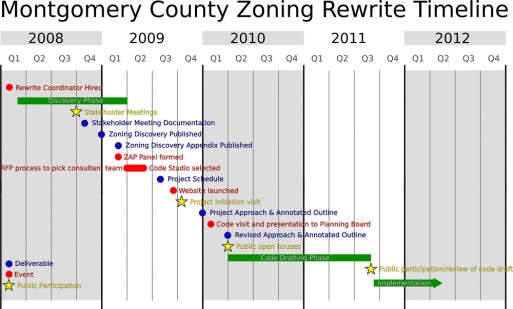Guest Post: Matt Johnson
Cross-posted at Greater Greater Washingtion
Zoning, the main tool to enact land use plans, is perhaps the most important part of planning. By specifying what, where and how new structures can be built, zoning gets things done.
In Montgomery County, a three-year project seeks to greatly simplify an unwieldy, outdated code and achieve strategic growth in a largely built-out county. The zoning rewrite won’t dramatically rezone the county to change the land use patterns, but the zoning code could improve the quality of development in Montgomery County by encouraging more sustainable and compact development and better public amenities.
Noon today, at the Rockville Library, the Planning Department will shed light on the rewrite project to date, from its diagnosis phase to the current draft of the revised zoning code’s outline/approach. The open house will feature half a dozen interactive displays.
Montgomery’s first zoning code was enacted in 1928. That year, the code had 5 zones and was 15 pages long. Over the years, it has been revised several times. When the code was last rewritten in 1977, Montgomery County was a vastly different place socially, politically, and economically. Perhaps the most significant difference is that today the county is running out of developable land.
With only about 4% of land in Montgomery County available for development, the new zoning code can play a crucial role in guiding redevelopment of areas like surface parking lots and strip shopping centers. The rules controlling that redevelopment are built into the zoning code and play an important role in achieving the kind of growth county residents want.
The open houses feature a visual presentation of what’s allowed in different zones, such as the mix of land uses, building design and public amenities. Other displays shed light on how zoning can help achieve sustainability goals, how to simplify the listing of land uses allowed in zones, and better define development standards like landscaping, lighting or parking to improve overall project quality.
The open houses are our latest attempt to show the public what we’re up to. We will be both showing our progress and listening to public input.
It’s important to note that the Rewrite is not a rezoning of the county. Changing the zoning of individual parcels typically occurs through a master planning process, like the one recently approved for White Flint. Using the rewrite to rezone would be comparable to using a sledge hammer to do the work of a screwdriver: it’s not only the wrong scale, it’s the wrong tool.
I’ll talk more about some of the difficulties of the current code and potential solutions in future installments. Meanwhile, we hope to see you at one of the open houses. If you can’t stop by, check out our virtual open houses.

Nancy
Nancy <3s zoning
Nancy
Nancy loves zoning.